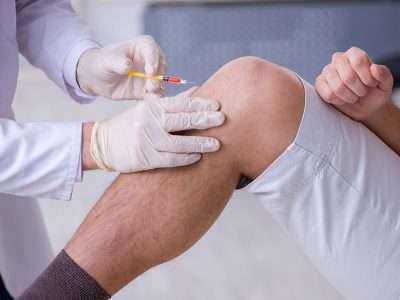 Knee pain is a common problem that can affect people of all ages. It can be caused by a variety of factors, such as arthritis, injury, and overuse. Chronic knee pain can make it difficult to perform daily activities and significantly impact one’s quality of life. While several treatment options are available, knee injections have emerged as an effective pain management procedure for helping alleviate knee pain and improve mobility.
Knee pain is a common problem that can affect people of all ages. It can be caused by a variety of factors, such as arthritis, injury, and overuse. Chronic knee pain can make it difficult to perform daily activities and significantly impact one’s quality of life. While several treatment options are available, knee injections have emerged as an effective pain management procedure for helping alleviate knee pain and improve mobility.
One of the leading causes of chronic disability in the United States is osteoarthritis of the knee. It develops slowly, and the pain it causes worsens over time. Osteoarthritis is the most common form of arthritis, which causes damage to a joint. Although there is no cure for osteoarthritis, when it affects the knees, a knee joint injection can help manage the pain.
In This Article:
- What is Knee a Injection?
- Conditions Treated with Knee Injections
- How Does a Knee Injection Work?
- Types of Knee Injections
- Who Can Benefit from a Knee Injection?
- Novus Spine & Pain Center
- Knee Injection Resources
What Is a Knee Injection?
A knee injection involves injecting medications directly into the knee joint to help alleviate inflammation and pain. The ends of the bones that make up the body’s joints have a covering of hyaline cartilage that helps the bones move smoothly against each other. It is the most common type of cartilage in the body and contains hyaluronic acid that works like a lubricant for the joint.
Osteoarthritis causes a lower-than-normal concentration of hyaluronic acid in the joints, allowing the cartilage to break down. When cartilage breaks down, the bones of the joint rub together abnormally, causing pain, stiffness, and swelling.
Conditions Treated with Knee Injections
Doctors use knee injections to treat and help diagnose pain arising from various knee joint conditions. Some of the more common reasons include the following:
- Pain Management. An injection of corticosteroids, local anesthetics, or other pain-relieving medications can help reduce knee pain caused by osteoarthritis, rheumatoid arthritis, bursitis, and other conditions. The type of medication, and the frequency of injections, depend on the cause of the pain.
- Diagnosis. The injection of a dye can help show the affected area on an X-ray to help identify the source of knee pain.
- Treatment. Injections can deliver therapeutic medications directly to the knee joint to help lubricate the joint or reduce pain caused by inflammation, and improve joint mobility.
Knee injections may be a treatment option when other pain management procedures, like physical therapy and over-the-counter pain medicines, have failed to provide pain relief. The treatment works best in people with mild or moderate arthritis. It is also a good option for patients wanting to delay joint surgery.
While knee injections are effective in treating osteoarthritis, the technique may also benefit people with other types of arthritis, like rheumatoid or hip arthritis.
How Does a Knee Injection Work?
A medicine is injected directly into the knee joint to reduce pain, help increase mobility, and allow more activity. Depending on the medicine in the injection, the treatment can range from a one-time treatment to weekly injections for three to five weeks. Pain relief usually occurs within 4 to 12 weeks. However, the effect can last for several months and can be repeated.
Although many patients report pain relief, others do not benefit from the procedure. Also, the injection may not be the best treatment option for all patients. Often, weight loss, exercise, stretching, activity modification, and anti-inflammatory medications are more effective treatments for some patients.
Types of Knee Injections
There are several different types of injections for treating osteoarthritis knee pain. Some of the options available include the following.
Steroid Injections (Cortisone Shots)
Steroid injections into the knee joint can help decrease inflammation and can do so with fewer side effects than steroid pills. A numbing agent (lidocaine) is mixed with the steroid to help relieve pain. Relief is almost instant because of the numbing agent combined with the steroid. The corticosteroid begins to curb inflammation within a few hours. The pain relief will vary for each patient and can last from several weeks to several months; however, some may not experience any benefit at all.
At most, steroid injections may be given every three months. However, more frequent steroid injections can speed up cartilage loss over time and possibly worsen osteoarthritis.
Hyaluronic Acid Gel Injections (Viscosupplementation)
The knee joint contains hyaluronic acid, a highly viscous and slippery substance the body produces naturally. Also known as hyaluronan or hyaluronate, hyaluronic acid is found throughout body parts such as the eyes, skin, and joints.
Hyaluronic acid gel injections (also known as viscosupplementation) replace the body’s naturally occurring lubricant. The treatment consists of weekly injections over three to five weeks into the knee. Although some patients report experiencing a degree of pain relief during the 3- to 5-week course of injections, most patients report the greatest pain relief occurring 8 to 12 weeks after beginning the injections. The length of pain relief varies; some patients have reported benefits for more than six months following the injections.
Hyaluronic injections are not a treatment for arthritis in all joints, and they tend to work more slowly than steroid injections. However, viscosupplementation typically has fewer side effects than steroid injections and can be repeated every six months.
Synthetic hyaluronic acid injections are marketed under several different brand names (Durolane, Euflexxa, and others). The U.S. Food and Drug Administration approved viscosupplementation in 1997.
Platelet-Rich Plasma Injections
Platelets are tiny blood cells that contain growth factors to promote healing. Plasma is the liquid part of blood. Platelet-Rich Plasma (PRP) is a concentration of platelet cells taken from the patient’s blood. The process involves taking some of the patient’s blood and processing it in a centrifuge to separate the various blood components, which concentrates the platelets. The process produces platelet-rich plasma (PRP), which is injected into the knee.
Some studies found PRP may help improve function and reduce pain in those suffering from mild to moderate osteoarthritis. PRP appears to work best for those whose osteoarthritis isn’t severe.
Who Can Benefit from a Knee Injection?
Knee injections are a pain treatment option typically administered after other non-invasive treatments like heat and cold packs, oral or topical medications, or physical therapy do not produce the desired results.
Knee injections can benefit people with chronic pain due to knee osteoarthritis and are most effective for those suffering from mild to moderate arthritis. The injections are less effective for obese patients with advanced osteoarthritis. The injections may also help reduce inflammation.
Although the injections may help provide some relief, the procedure does not reverse the arthritic process or re-grow cartilage.
Novus Spine & Pain Center
Novus Spine & Pain Center is in Lakeland, Florida, and treats patients with chronic pain with numerous therapies, including knee injections. By using a comprehensive approach and cutting-edge therapies, we work together with patients to restore function and regain an active lifestyle, while minimizing the need for opiates.
For your convenience, you may schedule an appointment online, request a call back, or call our office at 863-583-4445.
Knee Injection Resources
Viscosupplementation Treatment for Knee Arthritis (American Academy of Orthopaedic Surgeons)
Hyaluronan Injections for Knee Osteoarthritis (WebMD)
Hyaluronic Acid Injection for Knee Osteoarthritis: Procedure and Risks (Arthritis Health)
Hyaluronic Acid (Injection Route) (Mayo Clinic)
Injections That May Ease Your Joint Pain (Cleveland Clinic)
Injections for Knee Pain: Know Your Options (GoodRx)
Cortisone Shots (Cleveland Clinic)
Viscosupplementation Treatment for Arthritis (Johns Hopkins)
Joint Pain (WebMD)
Q and A: Osteoarthritis Signs, Symptoms, and Treatments with Dr. Plate (University of Pittsburg Medical Center)
Steroids and Hyaluronic Acid for Osteoarthritis (WebMD)
Platelet-Rich Plasma (Cleveland Clinic)
Platelet-rich plasma: a narrative review (PubMed)
Knee Joint Injection Image Gallery (Novus Spine & Pain Center)

